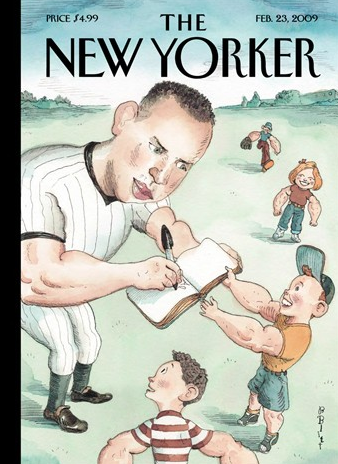Illustrator Barry Blitt has done it again. He has created yet another great New Yorker cover that parallels the one he did of Obama back in July of 2008. Only now, in the February 23 issue, we find a muscular Alex Rodgriguez signing autographs for steroid pumped children.

Blitt New Yorker -- Rodriguez
The illustration captures the conflicting drama of sports in America today: while we’ve been taught that sports–and particularly baseball–are about community, fair play, honor and courage, the notion that a player works as hard as she and he can for the benefit of the team, we find instead another reality–selfishness and hubris, egotism, deceit, cheating and scandal. And all of it the design of a production system that suggests that winning at any cost is what matters most.
The fundamental American principles of self-reliance, experience and pragmatism are nowhere evident. It’s no wonder we’re all confused.
Baseball was about redemption. It is a forgiving sport for players and viewers; it is also a contemplative sport. The point of baseball is to “come home”–round the bases home. It’s a space game. There’s plenty of time in baseball. But none of this is true anymore. Baseball is as harsh a sport as any other. Home is where the gold is. Possibilities are gone, as is the imagination. Like football, our current national pastime, baseball is now a finite game, about end results. And the end result is not winning, but rather, profit and loss.
In 2008, the 33 year old Rodriguez had a .302 average (.306 lifetime) and earned $28 million dollars. Coming into the 2008 season, the Yankees were valued somewhere between $200 million, to $1.2 billion; their revenue was $302 million (with $28 million in losses); and player costs, the largest expense, was approximately $200 million a year.
“The Yankees—read Steinbrenner—also own more than a third of the YES network, which broadcasts Yankees games to 8.7 million subscribers. The network’s revenues top a quarter billion and its profit margin is 60 percent. Though a completely separate business from the Yankees, YES’s value is directly tied to how much interest people have in the team, making a $200 million payroll a very easy decision.”**
The system corrupts. The profits for many owners, staggering. And players like Rodriguez are used to ensure that a franchise’s tentacles are many and reaching far and wide. It’s not surprising, then, that “A top baseball prospect from the Dominican Republic who received a $1.4 million signing bonus from the Washington Nationals lied about his age and name in what team president Stan Kasten called ‘an elaborate scheme.'”*** The Nationals signed a 16-year-old shortstop named Esmailyn “Smiley” Gonzalez. He was compared to U.S. Hall of Famer Ozzie Smith. “But while the Nationals have been listing his date of birth as Sept. 21, 1989 — which would make him 19 now — Kasten said on Wednesday that a Major League Baseball investigation determined Gonzalez was actually Carlos David Alvarez Lugo, born in November 1985 — meaning he was really 23.” ****
Money corrupts and the prospects of a lot of money earned early and fast corrupts even more. That’s the game now. That’s been American life for quite some time. This is why we can’t see ourselves coming out of this black hole for quite some time.
We learn from the historian Richard O. Davies, in Sports in American Life, A History, that “to be a sporting man in the mid-nineteenth century was to be someone who flouted rules of social acceptability by gravitating toward activities deemed inappropriate for a proper gentleman.” By mid-century this changed and sportsmen had good social standing and created outlets such as boating, swimming, horse racing, baseball, and so on. And by the end of the century, spontaneity is gone from sports and we find “formalized structures, written rules and bureaucratic organizations,” Davies tells us. Professionalism in sports is in–and it comes in with industrialization. Money–read profits–becomes central to the American experience.
Now in 2009, we have incredibly lavish sports venues, extraordinary media contracts and more highly paid stars than ever before. The stakes are high. So so much so that sports venues are sometimes created at the expense of communities nearby–the old Yankee Stadium and the South Bronx is a case in point.
The athlete as role model, in this system, is supplanted by the owner as king. The owner as plantation owner in a vituperative economic model dating back to slavery (see: William C. Rhodan, sports columnist for The New York Times, in Forty Million Dollar Slaves: The Rise, Fall, and Redemption of the Black Athlete /a star like David Beckham, at the time of this writing, is about to be traded–not loaned–to AC Milan). Money is privileged above all else. The premium placed on performance is extensive because the faster, bigger, and more powerful athlete has to hold the viewer’s attention. Salaries and on and off the field mayhem (Phelps’s pot smoking theatrical) are all part of the mediated experience of sports in America. Without it we don’t know what to make of our sports. We need the disjointed narrative to make sense of our oppressive lives that, with every day, appear to hang by a thread.

Phelps + Bong
Professional sports mirror American life and the reflection is bleak and dark. The American athlete is central to our collective experience. The professional athlete is a metaphor for our sense of self, our desires–but also our foibles, our darkest selves. It’s not surprising, then, that during these the darkest of times Mixed Marshall Arts, which used to be called caged fighting, extreme fighting, and no holds barred fighting, is one of the fastest growing spectator sports. Anything goes.
Bernie Madoff and R. Allen Stanford believed this–anything and everything was for their taking. Not unlike Rodriguez and “Smiley”-Lugo, Madoff and Stanford, who lived in an elite system, a bubble, sensed that they were somehow immune to the morals of our society and our socioeconomic systems. Rodriguez’s ready-made narrative is that he was young and naive, a stupid kid. Unknowingly he took steroids. In the case of “Smiley”-Lugo, MLB, agents and owners are all passing the buck, no one really taking responsibility, though there is a history of age irregularities in the league.
Why a 70 year old Madoff, so respected by Wall Street, would create a Ponzi Scheme, your guess is as good as mine. And why would Stanford involve himself in fraud is yet another mystery. But most distressing is the information we’re getting that some of the Madoff money comes from organized crime, while some of the money in the Stanford case comes from a Mexican drug cartel. Madoff and Stanford have allegedly been involved in money laundering. Anything goes, including the taking of people’s lives.
Madoff and Stanford, and Rodriguez and “Smiley”-Lugo are one and the same, born in a time where hubris reigns supreme; where what children see and experience is irrelevant–some will suffer, others will pull themselves up by their bootstraps and survive, and yet others, like those kids in the Blitt New Yorker cartoon will imitate Madoff and Stanford, Rodriguez and “Smiley”-Lugo. This is the most corrupting tragedy of all. Everyone is expendable. And when everyone is expendable, everyone is also a commodity.
Steroids, graft and corruption, these are the symptoms of a lost humanity.
In “Money for Idiots,” David Brooks tells us that, “Our moral and economic system is based on individual responsibility. It’s based on the idea that people have to live with the consequences of their decisions. This makes them more careful deciders. This means that society tends toward justice — people get what they deserve as much as possible.”
This is the ideal, not the reality. We find ourselves in a moment of real moral oscillation. We don’t know which end is up. We can only look at ourselves, though, and determine who and what we value,what’s closest to the human heart, what’s important. It may mean that in order to balance ourselves out, we have to also balance out idiots–but not criminals–as Brooks contends in his editorial piece.
In the meantime, in the South Bronx, within view of Yankee Stadium, a little girl, Pineapple is her name, Jonathan Kozol tells us in The Shame of the Nation: The Restoration of Apartheid Schooling in America, looks out towards Manhattan and describes us as “other people.” She fully understands that we live differently than she does–and she’s only in elementary school. What she sees–the Rodriguez’s and the Madoff’s and the Stanford’s–are what she calls “other people,” and they live different lives, touted as successful, luxuriant, wonderful. Just to get to school, Pineapple and friends have to walk through all sorts of dangers. As she looks outward past Yankee Stadium, how will she learn how to choose? Who will she be given who we are?








